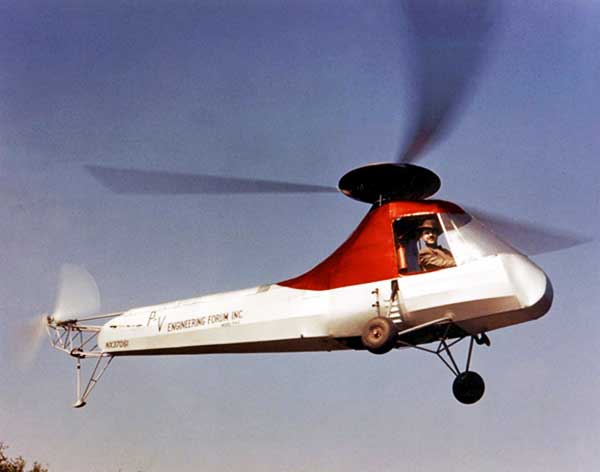| Picture |

|
| Manufacturer |
Piasecki
|
| Type |
PV-2
|
| Introduced |
4/11/1943
|
| In production? |
No
|
| Units produced |
1
|
| Price US $ |
0.00
|
| Overall Length |
0 ft
|
| Length |
24.5 ft
|
| Height |
7.5 ft
|
| Width |
7.9 ft
|
| |
|
| |
|
| Description |
The Piasecki PV-2 is a historically significant early helicopter designed by Frank Piasecki, president of the PV-Engineering forum, an organization created specifically to create Piasecki helicopters. Frank Piasecki is notable for being the first American to receive a helicopter license before a fixed-wing license. The PV-2 was an experimental aircraft widely recognized as being the second successful helicopter flown in the United States of America. The PV-2 showcased many technologies that are today a core part of helicopter engineering. It first flew on April 11 1943.The PV-2 had room only for a single occupant, which was of course the pilot. It was a small craft measuring 21 ft 6 in (6.55 m) in length, with a rotor diameter of 25 feet (7.6 m). The fuselage was covered with cloth. It was powered by a single 90 shaft horsepower Franklin engine. A four-cylinder, air-cooled unit. The PV-2 could hit a very respectable 100 miles per hour (161 kph), with a ferry range of 150 miles or 241 kilometers.The PV-2 demonstrated the effectiveness and practicality of dynamically balanced rotor blades, rigid tail rotors, tension-torsion pitch change systems and, most importantly, full cyclic and collective control.It is hard to understate how important a contribution the PV-2 made to helicopter aviation. At the time VTOL research was in its infancy and the PV-2 pushed the entire field ahead a whole generation in one fell swoop. It’s likely that had Piasecki’s vision not come to fruition we would not have modern helicopters that are as advanced as they are.Only one PV-2 was ever built and therefore this helicopter has to be considered one of the rarest pieces of aviation history in existence. It is currently preserved and on display at the National Air and Space Museum in an annex of the Washington Dulles International Airport.
|
| Advertisement |
|
| Design features |
- Dynamically balanced rotor blades
- Rigid tail rotor
- Full collective and cyclic pitch control
- Blades with Center-of-Gravity at a point forward of the Center-of-Lift
|
|
The Piasecki PV-2 is a historically significant early helicopter designed by Frank Piasecki, president of the PV-Engineering forum, an organization created specifically to create Piasecki helicopters. Frank Piasecki is notable for being the first American to receive a helicopter license before a fixed-wing license. The PV-2 was an experimental aircraft widely recognized as being the second successful helicopter flown in the United States of America. The PV-2 showcased many technologies that are today a core part of helicopter engineering. It first flew on April 11 1943.The PV-2 had room only for a single occupant, which was of course the pilot. It was a small craft measuring 21 ft 6 in (6.55 m) in length, with a rotor diameter of 25 feet (7.6 m). The fuselage was covered with cloth. It was powered by a single 90 shaft horsepower Franklin engine. A four-cylinder, air-cooled unit. The PV-2 could hit a very respectable 100 miles per hour (161 kph), with a ferry range of 150 miles or 241 kilometers.The PV-2 demonstrated the effectiveness and practicality of dynamically balanced rotor blades, rigid tail rotors, tension-torsion pitch change systems and, most importantly, full cyclic and collective control.It is hard to understate how important a contribution the PV-2 made to helicopter aviation. At the time VTOL research was in its infancy and the PV-2 pushed the entire field ahead a whole generation in one fell swoop. It’s likely that had Piasecki’s vision not come to fruition we would not have modern helicopters that are as advanced as they are.Only one PV-2 was ever built and therefore this helicopter has to be considered one of the rarest pieces of aviation history in existence. It is currently preserved and on display at the National Air and Space Museum in an annex of the Washington Dulles International Airport.
|
|
- Advertisement -
|
Design features:
- Dynamically balanced rotor blades
- Rigid tail rotor
- Full collective and cyclic pitch control
- Blades with Center-of-Gravity at a point forward of the Center-of-Lift
|
| Persons |
1
|
| Max. Range |
150 mi
|
| Cruise Speed |
84 mph
|
| Max. Speed |
100 mph
|
| Max. rate of Climb |
0 ft/min
|
| HOGE ceiling |
0 ft
|
| Service Ceiling |
0 ft
|
| Gross Weight |
1000 lb
|
| Empty Weigt |
750 lb
|
| Useful Load |
250 lb
|
| Fuel Capacity |
0 gallons
|
| Number of Engines |
1
|
| Engine Type |
Piston
|
| Engine Code |
Franklin
|
| Horse Power |
90
|
| Rotorhead |
Articulated
|
| Number of rotorblades |
3
|
| Rotor Diameter |
21 ft
|
| Number of tail rotorblades |
2
|
| Tailrotor Diameter |
0 ft
|
|